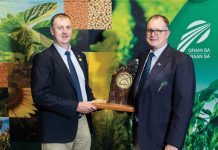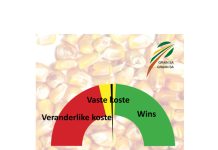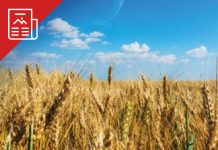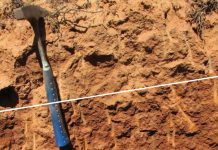



Scientific name: Senecio consanquineus
Afrikaans names: Radiatorbossie, Hongerbos-Senecio
English name: Starvation Senecio, Ragwort
Short description
Plants are vivid green, erect, semi-herbaceous, multi-branched, annual plants, up to 80 cm high, with long taproots. Stems are green with brown stripes, sparsely haired and finely corrugate. Leaves are simple, deeply lobed with round openings between the lobes, alternately arranged, sharply toothed (dentate) margins, both surfaces short, sticky haired, sessile, stem clasping, eared (auriculate), up to 9 cm long and 2 cm wide. Flowers are in oblong heads (capitula), in terminal corymbs, ray florets are bright yellow. Fruits (achenes) are narrow cylindrical, light brown, ribbed with white hairs on the ribs, sometimes bent and are up to 4 mm long and 0,5 mm wide. The pappus consist of numerous white bristles that fall off early and are easily spread by the wind.
Distribution
Senecio spp. is indigenous and is widely distributed through southern Africa. Other well-known species are S. madagascariensis that occurs more to the eastern parts of the country and S. latifolius that occurs mainly in KwaZulu-Natal.
Ragwort only propagates by means of seed and is a shallow germinator. It is a winter weed that germinates early in spring and which can develop dense stands when crops are harvested.
Control
Cultivation
Shallow cultivation can effectively control the weed.
Chemically
Ragwort can be controlled by post-emergence herbicides. Herbicides registered for the control of ragwort in wheat and maize are listed in Tabel 1 and Table 2. Ragwort can also be sprayed completely after harvest with a systemic herbicide like glyphosate, or a contact herbicide like paraquat.
TABLE 1: Herbicides registered for the control of starvation senecio in maize.
| Active Ingredient | Formula | Time of Application |
|---|---|---|
| bendioxide | 480 g/litre | Post-emergence |
| terbuthylazine/s-metolachlor | 497,2 / 102,8 g/ℓ | Pre-emergence and early post-emergence of the weed |
TABLE 2: Herbicides registered for the control of starvation senecio in wheat.
| Active ingredient | Formula | Time of application |
|---|---|---|
| bendioxide | 480 g/litre | Apply to young, actively growing weeds |
| chlorsulfuron | 400 g/kg | Apply when crop is in the two to five leaf stage |
| chlorsulfuron/metsulfuron methyl/tribenuron methyl | 119/79/222 g/kg | Apply when wheat is in four to six leaf stage |
| dicamba | 700 g/kg | Use only in tank mixtures with Enhancer (10 g - 12 g) and Reaper (10 g) and an adjuvant |
| metsulfuron-methyl | 200 g/kg 600 g/kg | Apply when crop is in the three to five leaf stage |
| metsulfuron-methyl/tribenuron-methyl | 120/600 g/kg | Use only in tank mixtures with 2,4-D ester (100 ml) or Voloxynil B 225 EC (0,75 litre) |
The effectivity of the herbicides however, decreases when the weeds increase in size. Producers should try to spray before it blooms and sheds its seed. Time of application is of utmost importance, but sometimes producers aren’t done harvesting when ragwort is at seedling stage. Strictly follow the specific instructions and dosages on the label of each product.
Always contact a reliable chemical advisor before using any chemicals to ensure the correct dosage and instructions are adhered to.
Contact the writers at elbe.hugo@syngenta.com (Elbe Hugo) and deweth@arc.agric.za (Hestia Nienaber).

















